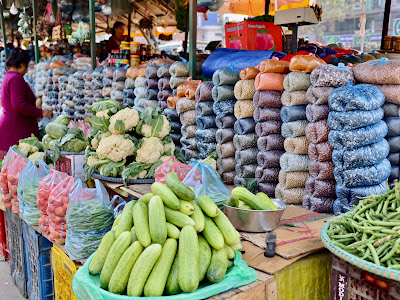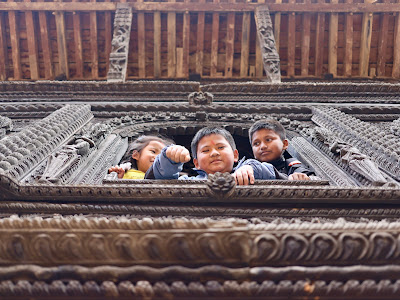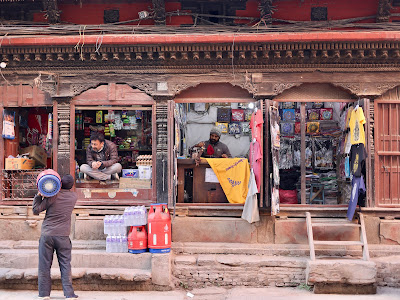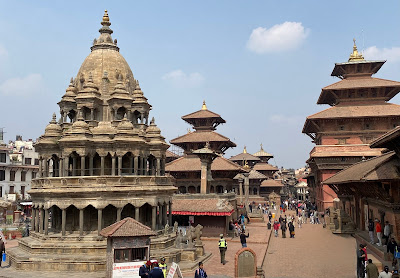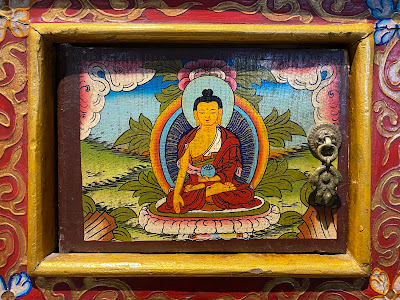We leave the Kathmandu through a route under construction that ascends the mountain following a curved route to the top. When crossing the mountain, the Trishuli River valley opens up, which collects water from small almost invisible streams at this time of year. We descend slowly between curves and works, while the mountains change the forest for cultivable terraces that, given the current drought, are simply dry land.
Along the river, the vegetable crops are leafy, filling the landscape with bright green, and in the local markets, vegetables and cereals create a party of colours and irresistible aromas. In addition, on the route we came across several groups of the Magar community, one of the largest indigenous groups in the country, who met to celebrate their heritage. Their costumes, music and dances, as they walked towards the meeting point, were quite a spectacle.
We arrived at the base of an impressive complex with a cable service (whose existence is difficult to understand) that ascends to the Hindu temple of Manakamana. We were surprised by the existence of this cable car, its size and the number of passengers. When it was our turn, we boarded the carriage and the ascent began; we could quickly observe the cultivable terraces that extend from the base to the top of the mountain, making their way through the remains of the forest and wooden plantations. At the arrival station, a corridor of stalls selling offerings, food and other accessories leads to the highest level, where the temple is located. The devotees prepare their offerings so that their requests are fulfilled by the goddess Bhagwati, a reincarnation of Parvati.
At the top, a row of visitors surrounds the temple, built in 1678, seeking to be in the presence of its goddess and receive her blessings. Unlike other temples, the offerings are left in the hands of the devotees. On one side, the coconuts are cracked open to be consumed; the candles are placed in the fire house along with everything that serves as fuel, including the beautiful plates made with leaves. The other items, such as baskets, malas and some flower necklaces, return to the hands of their owners, not without first being transferred to a plastic bag to return the offering basket, which has only been rented. Around the temple, the priests apply Tika, a thick mixture of coloured powders, threads and some binder. Families look for the best angle and pose for photographs, while the monkeys jump from one place to another, taking advantage of the morsels, seeds, and sweets left by the pilgrims.
Recalled in conversations with Alan for some time, the Gurkha commandos have been present with their great ability and their endless history of victories. At the end of 1700, the Gurkha Kingdom began the process of unifying the country's kingdoms, thus creating the Kingdom of Nepal, which remained in force until 2008. With this context, we decided to visit Gorkha. This municipality has the Gurkha Museum, a beautiful building that follows the architectural guidelines already seen in Patan and Kathmandu. It is beautifully preserved and has woodwork that deserves a detailed observation. The collection of rulers of the Gurkha kingdom allowed us to continue enriching our understanding of this historical mosaic.
Afterwards, we visited the royal palace, a fortress built with stone slabs and several levels of defence which make it almost impenetrable. The wooden balcony at the top of the building protrudes from the facade, creating a unique access to the view of the lower levels and a special quality in the architectural set. Its temple dedicated to Shiva stands out, which keeps the fire lit all year round and guarantees the ever-present offering of seeds and fruits for the monkeys of the place.
Bandipur is a small charming town. Its streets are mainly pedestrian, covered with stone and dotted with small shops and accommodations. On clear days, it is possible to see Annapurna and the surrounding mountains from the viewpoint. However, currently the air quality is so bad that you can see only a cloud of smog on the horizon.
Pokhara is the tourist centre of the area. Its streets are under construction, which generates considerable chaos in traffic, translated into stagnation and the annoyance of traffic police, who, as often happens, fail to control the traffic junction. The lakeside area is intensely dedicated to tourism, with buildings that are one hotel after another, interrupted only by small cafes, shops and restaurants.
Lake Phewa is a fundamental element of the landscape, people and life of Pokhara. We walked calmly along the path that borders the lake, listening to the singing of the starlings and crows that were preparing to rest. Both locals and visitors enjoyed themselves equally, and it was a perfect opportunity to recognise the traditional Magal and Newar clothing. At 6:00 pm the prayer begins, a Hindu ceremony in which three priests interact between music, fire, water, and songs. The congregation is a mixture of devotees and curious visitors like us, and the ceremony is preceded by a statement of all donations received on the day by those who wish to be fulfilled. At the end of the ceremony, the devotees line up to receive the blessings of the priests, while we leave the place.
We arrived at one of the entry points of the Annapurna conservation area. Up to this place, the road is paved and narrow, with beautiful curves, although still influenced by the smoke of the city. From there, the route becomes a slow circulation track, shared by walkers and jeeps that move through cliffs and deep canyons until they reach Ulleri.
When we reached the first and supported our body on the rest wall, the first raindrops began to fall, so we put on the rain jackets and continued on the road, enjoying the contrast between our hot bodies and the cold of the wind and the gentle rain. Just when we arrived at the place for lunch and for a decision, the downpour intensified. We had lunch, waited an hour to evaluate the conditions and decided to stay.
It was the best decision: the rain became stronger, and the winds moved the roofs; it would have been unpleasant to walk three more hours in those conditions, totally soaked. It was a perfect downpour in this tea house, as the hostels along the road are called in this territory. There was no other walker, so the whole family was around the fire in the main room. The fire is built in a metal drum connected to a duct that carries the smoke to the outside. Around this structure, a wooden frame is used to hang wet clothes and dry them on days like this.
The family is made up of three generations: the daughter is the administrator of the place, attends to the customers, and shares the kitchen work; the mother attends the place and the rooms with the grandmother and supports the kitchen; the father is the main cook and the grandfather takes care of the fire and the family tea during the day.
After having lunch and reading a little, Dinesh, our guide, invited us to play cards, introducing us to two Nepali games: Dhumbal and Yak. They were fun and appropriate for the moment.
A tree tomato appeared through the window and moved vigourously with the wind, which generated a conversation between the women around the room. This is how we arrive at the recipe for the spicy sauce that is used with the food. Thirty minutes later, I was with the father and daughter preparing the night's sauce. It was a delicious experience; in addition, they explained to me the secrets of **dal**, chicken curry and the Tibetan bread that is used in the region for breakfast. While this was happening, Alan discovered the rum from Nepal and, for academic purposes, began its tasting, which allowed us to try accompaniments that we had not tried, thus completing an unexpected and wonderful evening.
Alan y Marce

